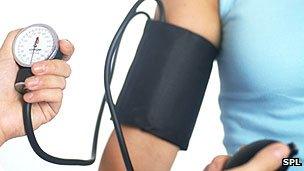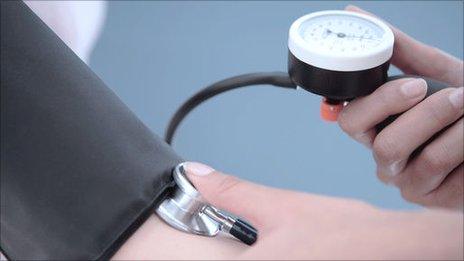Arm blood pressure differences 'predict death risk'
- Published

Pressure when the heart is pumping blood is measured in millimetres of mercury (mm Hg)
A large difference between the blood pressure in each arm suggests a bigger risk of dying early, researchers claim.
A study of 230 high blood pressure patients found those with big differences in systolic pressure were more likely to die from heart attack, stroke or other causes.
More heart health checks may be needed in those with different readings, says the British Heart Foundation.
Not all medics follow national guidance to measure blood pressure in both arms.
Dr Christopher Clark from the Peninsula College of Medicine and Dentistry at the University of Exeter, who led the study, published in the British Medical Journal, external, said the message to doctors was simple.
"Sorry guys, but you really need to follow the guidelines by measuring both arms when you're assessing blood pressure," he told the BBC.
He said patients with high blood pressure who routinely checked their blood pressure at home should also follow the advice.
"If they are being treated on the basis of their blood pressure, it's important to know if there's a difference between arms so they know their treatment is based on the correct measurements in the future."
A previous analysis of 28 study papers in The Lancet, external also found that a large difference in readings could mean an increased risk of vascular disease and death.
Maureen Talbot, senior cardiac nurse at the British Heart Foundation, said: "This study supports national guidelines, which recommend that blood pressure readings are taken in both arms. It is normal to have a small difference in your blood pressure readings between arms.
"However, a big difference between your readings may carry risks, so more tests could be needed to check your heart health. If you want to find out your blood pressure, visit your GP or practice nurse to have it measured."
People with different readings in each arm may have peripheral vascular disease, which often shows no symptoms.
Stopping smoking, or medication to lower blood pressure or cholesterol, may help reduce the risk of heart problems or stroke in these patients.
- Published24 August 2011
